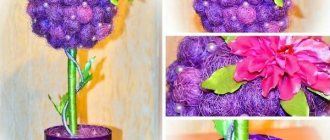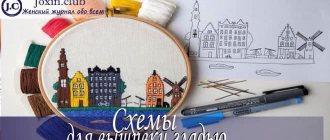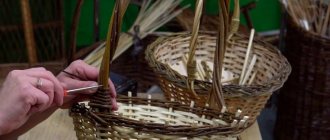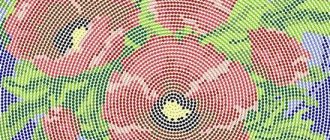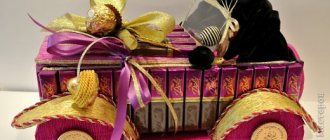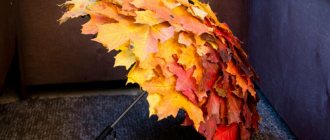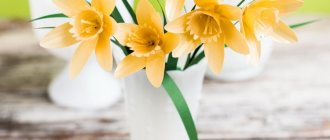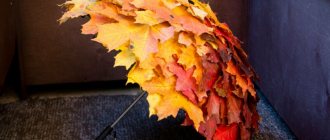The long-awaited autumn season has arrived. A time of dreams and new achievements. Right now, nature delights us more than ever with its beauty, a riot of colors, a refreshing but still warm breeze, rustling leaves under our feet. And I really want to preserve the feeling of complete harmony and warmth for as long as possible, not only in my memories, but also in my home! Autumn foliage will come in handy, and flowers made from tree leaves with your own hands will be a wonderful interior decoration or an unusual gift for a loved one.
This work will not require you to spend a lot of money or time, but in its originality and beauty it is in no way inferior to other crafts made from scrap materials.
Flowers from tree leaves: master class
Roses made from rose leaves look most impressive and natural in compositions and simple bouquets. The process is quite exciting and very simple, so the whole family, including children, can take part in it.
Once you start making such a craft, you will understand that the stage of collecting leaves is much longer and more tedious than the creative process itself. The following trees are best suited, the foliage of which is preferable to use for making autumn roses: maple, ash and wild grapes. Try to choose bright leaves in colorful shades (yellow, red, maroon, green). If possible, use leaves from trees rather than those picked from the ground. They will not only be cleaner and less damaged, but more importantly, they will also be quite elastic due to the retained moisture, it will be much easier to work with them, and the composition using them will turn out to be more realistic. Collect leaves of different sizes. The splendor of the rose will depend on the number of leaf petals used.
So, the basic material is already in your hands, are you full of desire and enthusiasm? Then let's quickly look at how to make flowers from tree leaves with your own hands.
Making figures from flowers
Small-sized autumn flowers are quite suitable for creating figures. These can be animals or people. Dried autumn flowers are useful for such crafts. The figure is laid out on cardboard and glued with glue. The design is completed by placing the composition in a frame.
Related article: Do-it-yourself upholstered furniture for a nursery: mini-sofa
Necessary tools
To make this craft you will need:
- leaves;
- scissors;
- threads or thin rope;
- sunflower oil or hairspray;
- iron.
Use flowers from tree leaves of different colors or alternate different colored leaves in one rose - it all depends on your taste.
To create not just a bouquet, but a separate composition, you can use other natural materials (rowan berries, pine cones, spruce branches, chestnuts, acorns, etc.).
Methods for drying plants
Before you make any compositions and bouquets that will last you all winter and will please the eye, first you need to somehow dry the flowers and other natural materials that you will use for this. Let's see what options there are for drying plants and flowers.
Cold drying
This drying method is quite simple. After a week, the herbarium can be used for work. When using leaves for garlands and other compositions other than collages. This drying does not require a press. Natural materials must be laid out on paper and carefully straightened. Flowers need to be tied into a bunch and hung in inflorescences in them. The room where plants are dried should have good air circulation and should not be humid. Plants dry well in this way and do not lose their appearance.
Hot drying
You can also dry the gifts of nature with an iron. This method allows you to preserve the appearance of the flowers. They are placed on paper, a sheet of paper is placed on top, and then the materials are ironed until the moisture has completely evaporated. It is recommended to dry large flowers in the oven at low temperature.
Related article: Light in the basement of a residential building and garage with your own hands
Powder drying
Any bulk substance that absorbs moisture, for example: sand, semolina, salt, can be used as a powder. This method can help preserve the shape and color of plants. The entire process will take 2-3 weeks. You need to take a box, pour hygroscopic material into it - two centimeters after that you need to fold the flowers and cover them with the same material on top.
Step-by-step execution
First, take the sheet with the back side facing you so that its front side is directed towards your palms, and fold it in half.
So let's get started. Making flowers from tree leaves step by step:
1. Roll the resulting half of the leaf into a tight tube - this will be the core of our future flower.
2. Take the second sheet. It must be positioned with the front side inward.
3. Bend this sheet outward so that its top protrudes 1-2 mm above the previous one. Wrap the resulting half around the base.
4. Repeat this manipulation several more times. Depending on how many leaves you make will determine the size of the rose.
5. Each subsequent row of leaves must be moved slightly lower. This way the finished rose will be more fluffy, voluminous and beautiful.
6. Secure the base of the resulting flower tightly with thread.
7. On top, lightly soak the flowers from tree leaves with sunflower oil. This will give the finished product shine and help preserve it longer.
8. Instead of oil, you can use hairspray. By lightly sprinkling the flowers, you will also give them shine, and this manipulation will also protect them from fragility.
9. If desired, you can make individual strokes of gold paint or glitter over the roses.
10. Finally, all that remains is to arrange the resulting autumn flowers into a bouquet and decorate them with the most colorful and neat leaves. Be sure to iron these leaves through fabric or a double sheet of paper first.
Flowers made from tree leaves, made by yourself, are ready. You and your loved ones will certainly like them. In addition, such a bouquet can be a wonderful gift that will preserve the love and warmth of your hands.
Ideas for crafts from autumn flowers: photos
As you can see, you can create many different crafts from flowers, leaves and other autumn natural materials. And if it’s difficult for you to come up with ideas yourself, I suggest you look at the photo gallery selected for you, in which you will surely pick up something interesting for your apartment.
The best posts
- Old-fashioned details in the kitchen interior that are best abandoned
- Wallpaper with gerberas is a bright solution for your home interior
- What did you forget when arranging your kitchen? Typical mistakes
- How to move the sink?
- The most beautiful wallpaper in the living room: photos of new products
- DIY ribbon bow with step-by-step photos and videos for a gift
- DIY Easter egg made from plywood and thread with photos and videos
- Assembling puffs on curtains with tucks: sew them yourself
Features of blanks
You can form tubes by winding them on long skewers, pencils, knitting needles or other oblong devices. The size and density of the finished petals will depend on the diameter of the rod used. Give them the desired shape according to your desire and artistic taste.
The resulting flowers from tree leaves must be securely fixed with glue and thread. You can first coat each leaf with glue and roll it into a tube, or, conversely, glue the finished piece and fix it with a thread for the drying period, not forgetting to remove it at the end of the cooking process.
After all the blanks are ready and the tubes have been wound in sufficient quantities, proceed directly to the formation of the flower.
It is best to play with the resulting blank and give it the appearance of a real plant by fixing the flower on a long skewer or thick wire. At the base (for the sepals) it is recommended to use small green leaves or make them yourself from corrugated or colored paper. Be sure to wrap the stem itself with the same green corrugated paper or special tape.
As you can see, just a little effort, and the finished chrysanthemum flower from an unusual natural material is already ready. Now they can complement any autumn composition or, by making a few more of these flowers, create a separate lush bouquet of chrysanthemums. Place such a bouquet in a vase, decorate it and enjoy the beauty of this wonderful autumn flower for a long time.
Flower arrangement with basket
To create a beautiful autumn bouquet you will need an old basket in which you can place fresh flowers and herbs. To prevent flowers from wilting, florist shops sell a special material resembling spongy plasticine into which flowers are stuck. Thus, the bouquet will retain its freshness for a long time due to the moisture in the sponge. You can create a wonderful composition from dried flowers and complement it with coniferous branches with cones or herbs. If necessary, dry bouquets can be painted in the desired color from a spray can. For a more durable composition, a dried herbarium is suitable.
Related article: Old photos in the interior (43 photos)
Why is it so important to involve children in collecting herbariums?
The school curriculum for such general education subjects as biology, natural history, and natural history necessarily includes the topic of the herbarium. As homework, the teacher often asks students to collect a herbarium and make interesting crafts from a herbarium made up of plants from their area or some specific plants.
Translated from Latin, herbarium means “grass.” It is a collection of plants dried according to the rules.
To do this work correctly, you need to study the following points in detail:
- how to collect a herbarium,
- what are the features of the subsequent design of such a collection,
- how you can creatively modify the collection,
- how to preserve your herbarium for a long time so that memories from childhood remain.
The herbarium can contain either a single flower or branch or a whole plant.
The answers to all the above questions are described below.
How to collect specimens for a herbarium
The answer to the questions: how and when to collect specimens for the herbarium depends on the goal set by the teacher. For example, collect a herbarium of early spring primroses that grow in your area. A prerequisite for collecting such plants is a clear sunny day and a walk through the adjacent forested area.
Initially, herbariums appeared in Italy at the beginning of the 15th century.
ATTENTION! Do not let your child go alone or even in company with peers. Regardless of the season of the year, there are enough poisonous plants, snakes, and insects in nature that are dangerous to touch. Control and protection of an adult from such troubles is necessary!
Take with you:
- Handy tools (a small shovel for digging up a plant with its roots and dry paper napkins to remove excess moisture from the leaves and unnecessary clods of earth from the roots);
- A thick book, between the sheets of which it is convenient to place picked plants;
- A container of water to wash your hands after, and a towel.
The founder of this art form was the famous botanist of the Pisa Botanical Garden, Luce Ghini.
ADVICE! You need to choose plants with the least amount of external damage, with clean leaves and beautifully blooming flowers.
Algorithm for collecting plants for the herbarium:
- Choose a plant that is smooth and not damaged by insects and fungal diseases in the flowering phase;
- To be able to imagine and see all the plant elements of a particular species, you should carefully dig up the root of the plant and lightly shake the earth off it;
- Then unfold the paper napkin, put the plant on one half and cover with the other half of the napkin, press lightly for a couple of seconds - all excess moisture and dirt will be absorbed into the paper;
- Now you can place the plant between book sheets to keep the shape of the plant almost unchanged.
Most people turn collecting plants, flowers and creating compositions from them into a hobby.
RECOMMENDATIONS! Under the press of book pages, the dried herbarium turns out almost flat. If it is necessary to preserve the volume of the plant, then it must be dried in a dark, dry, but cool (not higher than +15 C) place.
To make a herbarium, you can collect completely different plants.
